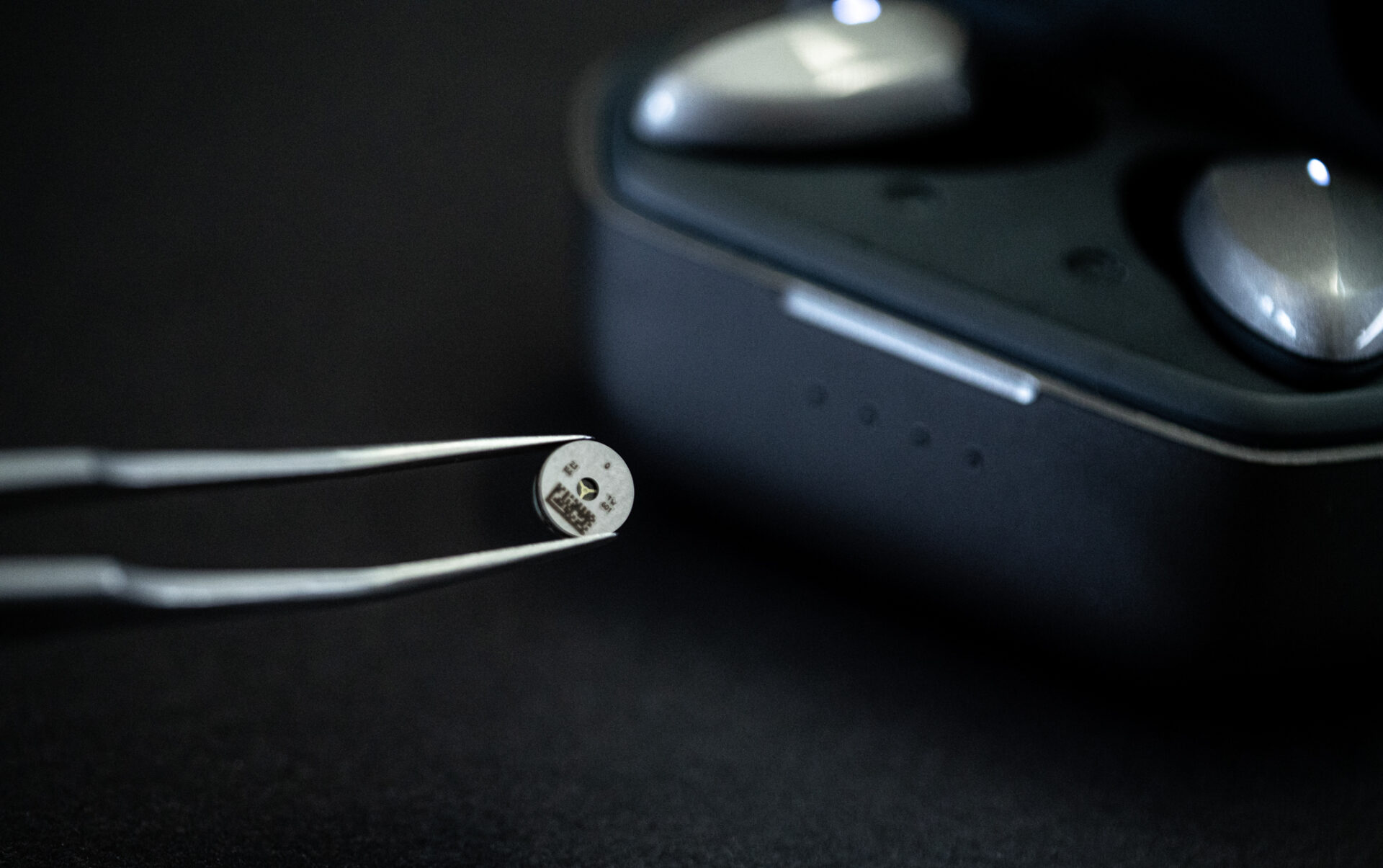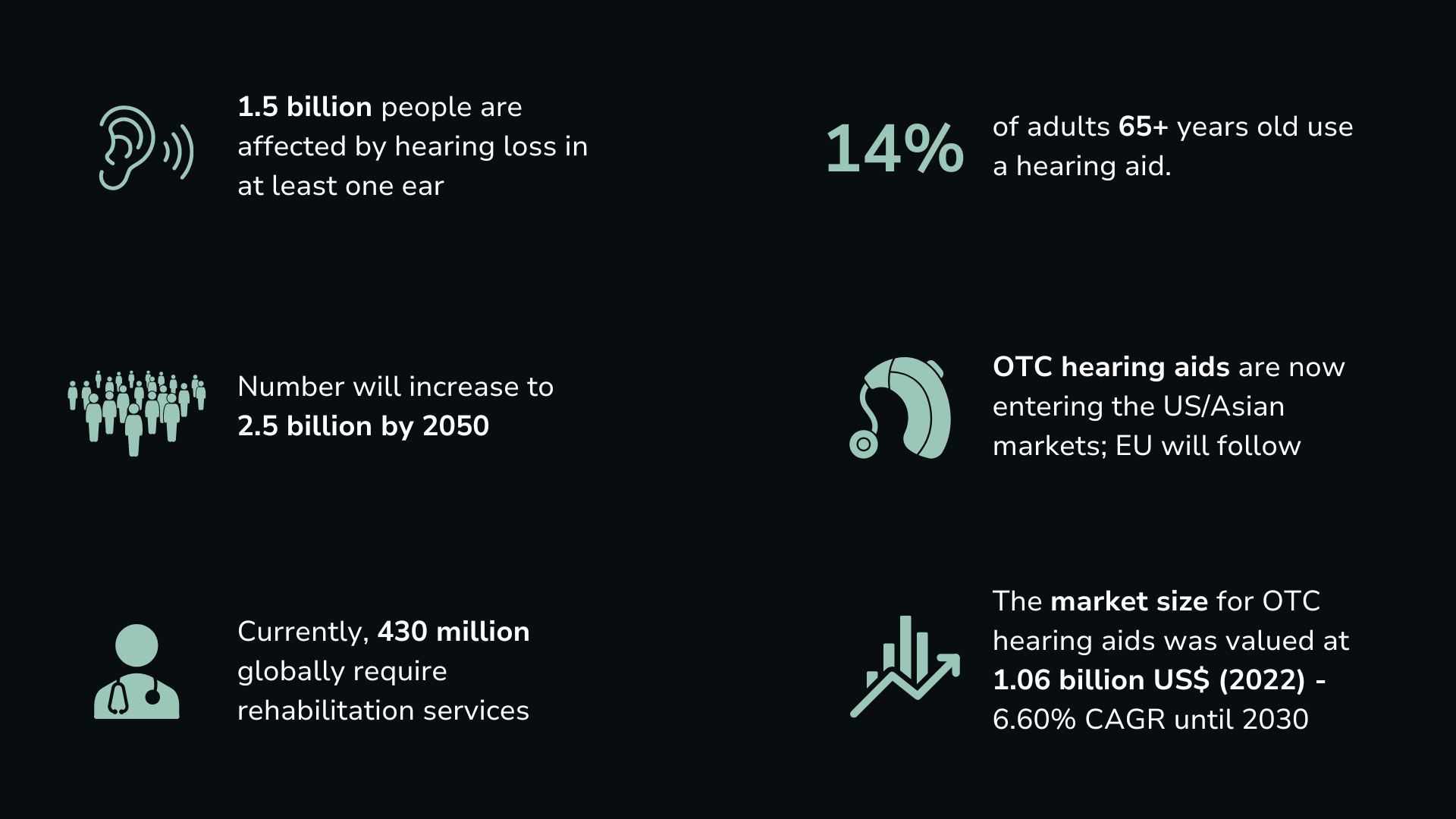
Published:
MEMS-Based OTC Hearing Aids Are Changing Lives
More than a billion people will benefit from a new product that has already penetrated the US and Asian markets. Over-the-counter (OTC) hearing aids cater to a new consumer segment that demands affordable, easily accessible, and ergonomic hearing aids. Due to their size, design flexibility, and audio performance, MEMS speakers are paving the way, ramping up the production of hearing aids that do not require a prescription.
Deafening statistics
It is estimated that 14% of adults who are above the age of 65 are currently using a hearing aid. At the same time, more than 1.5 billion people are affected by moderate to severe hearing loss around the globe, according to the World Health Organization (WHO). The number is going to increase to 2.5 billion by 2050, with hundreds of millions of people requiring rehabilitation services. The statistics are deafening, yet it is a problem few have heard of.

Based on data from the WHO.
Varying from mild to profound, hearing loss refers to the inability to hear sounds that a healthy individual can hear (SPL range: 0 to 130 dB). A hearing loss up to 20 dB above the hearing threshold is still considered to be normal hearing. Proper hearing loss starts being diagnosed when the individual’s hearing sensitivity has shifted up by 20-25 dB to 40 dB, which is referred to as “mild hearing loss”. This means that this person may hear some speech sounds, but has difficulty hearing sounds such as normal breathing or a soft whisper. A person with moderate hearing loss (40 – 60 dB offset) might have a hard time understanding when another person is talking at a normal speech level. Severe hearing loss (60 – 80 dB offset) almost totally prevents the individual from hearing the voice of a person talking at a normal level, except for very loud sounds. With profound hearing impairment, the individual is not able to hear any speech or conventional household acoustic inputs, such as a vacuum cleaner or a washing machine, since their hearing threshold shift exceeds 80 dB. The higher the hearing threshold, the lower the hearing sensitivity, making it impossible for the individual to detect soft sounds.
Although there are many levels of hearing impairment, one does not have to reach deafness to have a disabling condition. According to the WHO, “disabling hearing loss” refers to a hearing threshold shift exceeding 35 dB, which falls within the mild to moderate hearing impairment category. Living with untreated hearing conditions not only poses a threat to the individual’s safety, as the sense of hearing alerts us to imminent dangers, but also causes a myriad of problems, from psychosocial adjustments to negative career outcomes.
A silent “epidemic”
Although hearing impairment is prevalent among those who are above the age of 65, with 14% of older individuals in the US using a hearing aid device, young people are also affected.
More than half of American adults aged 40 and older acknowledged lacking excellent hearing, but only 8% of them have been treated, and only 20-25% of people who need a hearing aid do actually get one.
In developing countries, a large number of children lose their hearing ability due to untreated infections, exposure to ototoxic drugs, and nutritional deficiencies. According to the WHO, 60% of these children do not receive schooling, resulting in higher unemployment rates, poverty, and social isolation. Access to affordable assistive listening devices would be life-changing for these children, who are often not covered by universal healthcare.
Simultaneously, developed countries, such as the US, are also observing a change in their hearing loss demographics. More and more young adults are reportedly affected by moderate hearing loss, partly due to prolonged headphone use and repeated exposure to loud sounds. In May 2023, Phonak, a prescription hearing aids manufacturer, stated during an interview with The New York Times: “the number of Americans between the ages of 22 and 54 who have been fitted with the company’s hearing aids increased by 14 percent more than the increase for users of all other ages between 2017 and 2021.” For this market segment, accessibility and affordability are important; so are the availability of ergonomic and appealing devices.
OTC hearing aids: an alternative to prescription hearing aids
Over-the-counter (OTC) hearing aids are a new product that caters to the increasing number of people with perceived mild-to-moderate hearing loss. As the name suggests, they do not require a doctor’s prescription and can be easily purchased in retail stores or online. In 2022, the US Food and Drug Administration issued a final rule to improve access to assistive listening devices by establishing this new product category.
OTC hearing aids are air-conduction devices which, as opposed to bone-anchored hearing aids, do not require implantation or any surgical intervention. They amplify the ambient sound and direct it into the ear canal. OTCs are intended for use only by people 18+ years of age to compensate for mild to moderate (20 – 60 dB) hearing loss.
OTCs are proper medical devices and should be sold as such. However, they are available to consumers “over-the-counter” without a doctor’s prescription or the guidance and support of a licensed healthcare professional.
Users can customize the device and control its settings based on their needs, through tools, hearing tests, and dedicated software.
FDA OTC regulations
The Food and Drug Administration (FDA) has established specific regulations that manufacturers of OTC hearing aids need to follow to ensure that these devices are safe and effective.
OTC hearing aids are not intended for people younger than 18, in which case only proper hearing aids can be prescribed and sold by audiologists, doctors, or licensed health care professionals.
Most OTCs use wireless technology, and they can be categorized either as “self-fitting” or “non-self-fitting” devices.
- Self-fitting OTCs (more complex and hence more expensive) offer a hearing test to adjust the settings and tune the device to fit the specific user’s hearing loss profile. Manufacturers must demonstrate to the FDA that these hearing aids have been properly tested and are safe (e.g., volume control and output limits) and effective for adults with mild to moderate hearing loss. Once this has been proved, the devices can use the words “FDA cleared” on packaging, labels and ads.
- On the other hand, non-self-fitting devices only come with volume control and a few predetermined settings. They must also be registered with the FDA, but manufacturers are not required to demonstrate that the devices are safe.
Independent of the self-fitting characteristics, all OTCs are required to have a user-adjustable volume control. The acoustic output limit has been fixed by the FDA for OTC hearing aids and set to 111 dB SPL, or 117 dB SPL if the device is equipped with activated input-controlled compression. Similarly, the device insertion depth has been specified: the earpiece’s tip must stay > 10 mm from the tympanic membrane.
The outside-the-box labeling has also been regulated by the FDA. It should include, among other things:
- warning against use in people younger than 18;
- suitability for mild to moderate hearing loss only;
- prominently displayed “OTC” and “hearing aid” words on the packaging;
- advice on when to seek health care services;
- “Red-flag” conditions requiring a doctor’s attention;
- manufacturer’s contact information and return policy.
OTC hearing aids market
The projections for the US OTC hearing aids market are highly positive, with a recent report valuing it at more than 1.06 billion USD, with an expected record of more than 6.60% Compound Annual Growth Rate (CAGR) from 2023 to 2030. Currently, more than 40 companies are already selling OTC devices, with over 80 companies having filed registrations with the FDA.
The main goals of the OTC market are accessibility, affordability, and innovation.
In fact, for people living a long distance from the nearest hearing care professional, increased access is a crucial aspect to consider.
A study published by the American Speech-Language-Hearing Association (ASHA) in September 2023 states that only 2% of American adults aged 40 and older who have hearing difficulties purchased an OTC hearing aid, and only 4% reported that they are likely to purchase OTCs in the following year. An important element contributing to the choice of an OTC is the possibility to cover its cost through personal health insurance. Hearing aids are covered by insurance providers in most European countries, such as Austria and Germany, but they are not in the US.
Similar behavior has been observed in other regions, such as Asia-Pacific, where OTC hearing aids are already sold at a fraction of what prescription hearing devices usually cost.
Buyers in the ASHA survey paid an average of $233 for OTC hearing aids, and those intending to buy estimate they would spend about $200.
With regards to the last market goal, not much innovation has been experienced in the OTC market so far, except for some unusual form factors and unconventional applications (e.g., head-bands). Most OTC features are equivalent to those found in prescription hearing aids. Innovation in chips is proceeding rapidly, especially in embedding powerful neural networks capable of running complex algorithms to separate (or enhance) speech from noise or to provide advanced noise cancellation and occlusion reduction.
MEMS speakers for OTC hearing aids
All styles of hearing aids, from BTEs to CICs, are relatively small devices that require components that are both robust and small in size. To create the assisting listening aids their customers desire, manufacturers are seeking speakers that are small and flexible, while meeting the strict audio resolution requirements for hearing aids.

USound’s MEMS speakers are one of the thinnest speakers available on the market for OTC applications.
USound MEMS speakers represent the ideal solution for this type of application, as they are the thinnest high-performing microspeakers on the market. Our Conamara series is specifically developed for this type of miniature device, offering an almost flat and wide frequency response in the whole audio range. Its tiny form factor does not exceed 6 mm in diameter and 1.5 mm in thickness, while its round shape and SMT reflow soldering capabilities offer both design and integration flexibility.

USound’s Conamara series offers the best MEMS speaker solution for OTC hearing aids.
Moreover, USound’s Conamara speakers are IPX8 certified and can be safely submerged underwater for 30 meters in depth for up to 30 minutes. Water-resistant speakers are ideal for designing lifestyle devices, such as OTC hearing aids, which are normally worn for prolonged periods. The user can wear them while showering and swimming, or while he/she is exposed to humid and wet environments.
As already mentioned, affordability represents one of the key pillars of the OTC market. MEMS speakers represent an ideal choice for this purpose, providing manufacturers with a new solution that helps reduce production costs thanks to their Surface Mount Technology (SMT) reflow capability. This technology eliminates the need for manual handling of the speakers, reducing the likelihood of human errors and improving manufacturing speed and yield. The combination of USound speakers’ SMT reflow soldering capabilities and their tiny form factor makes it possible to use a fully automated pick-and-place assembly process to achieve a high product quality (extremely low part-to-part variability) at a fraction of the production cost.
Last but not least, it is paramount to mention how important power efficiency is for an OTC hearing aid. These devices, unlike prescription hearing aids, should be considered as “situational devices”. They are not intended to be worn for an extended period of time, but rather while their help is needed: a conference, an environment with several noise sources, a cozy evening in front of the TV, etc. This rarely translates into a daily wearing time of more than 7-8 hours. Nonetheless, not all devices are able to provide this battery life. USound has got the solution also in this case, releasing the Tarvos 1.0 UC-P3010 linear audio amplifier. In combination with USound MEMS speakers, Tarvos 1.0 uses way less energy and takes up less space compared to more traditional coil-based audio solutions, and therefore represents the best candidate to pair with USound MEMS speakers for your new OTC hearing aid.
In another article, we discuss the benefits of USound’s Conamara speakers for TWS and OTC hearing aid applications in great detail.
USound offers many more solutions for OTC hearing aids, including Kore 4.0 audio module and hearing aid reference designs. If you are interested in purchasing, testing, or learning more about our products, do not hesitate to contact us. One of our experts will provide you with the information you need.

About the Author
Andrea Greco is a Field Application Engineer at USound. He has international experience as an Acoustics Engineer, with a background in both acoustics and music. LinkedIn
This article was originally co-written by Marielena Perpiraki, a former team member, and has been updated by our editorial team to reflect current best practices.

